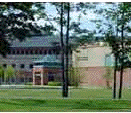









|
|
| |
ME
639: ADVANCED TURBULENCE
|
| |
Syllabus 

|
| |
|
| |
Course Specifications |
| |
|
| |
|
| |
Textbook: None |
| |
Instructor
: Goodarz
Ahmadi (CAMP 267,
268-2322)
Office
Hours: Monday and Wednesday 12:30 - 3:30 p.m. |
| |
|
| |
Course
Sites: 1)
https://webspace.clarkson.edu/projects/fluidflow/public_html/courses/me639/index.html
2)
https://sites.clarkson.edu/gahmadi/courses/me639/
|
| |
Prerequisites: ME
527 |
| |
|
| |
|
| |
Course Learning
Objectives |
| |
|
| |
- To provide the students with a fundamental
understanding of turbulent flows.
- To familiarize the students with the stochastic
and chaotic nature of turbulence.
- To provide the students with the tools for
modeling turbulent flows.
- To familiarize the students with the
statistical theories of turbulence.
- To familiarize the student with simulation
techniques in turbulent flows.
- To familiarize the students with applications
of turbulence in industry
and environment.
|
| |
|
| |
Course Learning
Outcomes |
| |
|
| |
Objective 1: |
| |
- Students will
demonstrate an understanding of the fundamental
physics of turbulent flows. Students will be able
to analyze the transport of moment, energy, and
vorticity in turbulent flows.
|
| |
Objective 2: |
| |
- Students will
be able to analyze simple shear, wall bounded and boundary
layer flows with the use of phenomenological models of
turbulence.
Students will become familiar with recent and advanced higher order
modeling
of turbulent shear flows. Students will be able to analyze
turbulent
flows in complex regions with the use of commercial codes.
|
| |
Objective 3: |
| |
- Students will become familiar with the direct
and large-eddy simulation
of turbulent flows. Students will become familiar with the
classical
and modern statistical theories of turbulence.
|
| |
Objective 4: |
| |
- Students will perform stochastic simulations in
their respective fields
of interest. Students will become familiar with the applications of
turbulence
in industry and environment.
|
| |
|
| |
Course
Outline |
| |
|
| |
|
II. PHYSICS OF TURBULENCE
III. TURBULENT
SHEAR FLOWS
|
|
|
STATISTICAL THEORIES
OF
TURBULENCE
- Homogeneous Isotropic Turbulence
- Karman-Howarth Equations
- Lundgren's Theory
- Chung's Kinetic Theory of
Turbulence
- Pope's pdf Model
- Orthogonal Basis
- First Order System
- Navier-Stokes System
- Low Dimensional Dynamical System
- Applications to Modeling
- Orthogonal
Random Functions
- Meecham's Theory
- Kraichnan's Direct Interaction Theory
- Infinitesimal Impulse Response
- Eulerian Direct Interaction Approximation
-
Hopf's Characteristic Functional Theory of Turbulence
- Lewis-Kraichnan Approach
- Coherent
Structures
- Wavelet
Transform
- Stochastic
Estimation
- Pseudo-Flow
Visualization |
|
|
|
| |
| |
|
| |
Evaluation Methods |
| |
|
| |
- Homework 10%
- Exam-1 25% March
15, 4:00-5:15, CAMP 178
- Final Exam 35% Final
Exam Week
- Project 1
10% February
22
- Project 2
20% April 23
|
| |
|
| |
Course Description |
| |
|
| |
ME
639 Advanced Turbulence R-3, C-3.
Prerequisites: ME 527 or equivalent.
Review of viscous flow theory. Review of
instability of viscous flows.
Origin of turbulence. Phenomenological theories of turbulence.
Reynolds'
equation. Energy budget and vorticity dynamics in turbulence. Free
shear
and internal flows. Turbulent boundary layer. Introduction to
turbulence
modeling. The k-e and stress transport models. Recent
developments
in turbulence modeling, stress transport models, multipoint closure
methods,
and thermodynamical formulation. Turbulent diffusion, isotropic
turbulence
and Karman-Howarth equation. Kraichnan's direct interaction
approximation.Wiener-Hermite
expansion approach. Characteristic functional formulation and Hopf's
theory.
Lundgren's probabilistic formulation and Chung's kinetic theory of
turbulence.
Direct and Large-Eddy simulation techniques. Proper orthogonal
decomposition
Techniques. Chaos and dynamical systems, stochastic Estimation,
Lagrargian
mean approaches. |
| |
|
| |
Exam & Homework
Policies |
| |
|
| |
Exam Policy |
| |
Exams will be open book.
|
| |
Homework Policy |
| |
Homework will be collected as
assigned. Homework will be graded and returned to the
students. |
| |
|
|
|